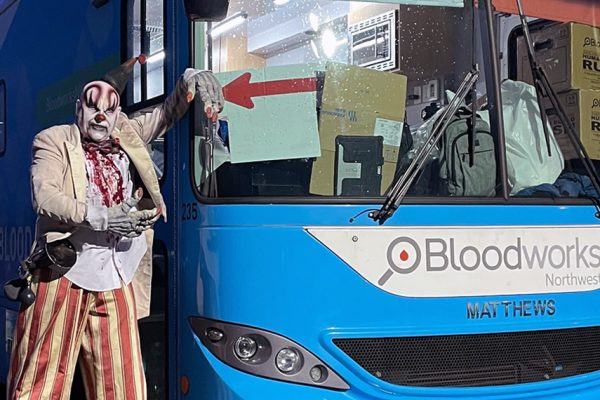The Pacific Northwest knows Bloodworks as the go-to resource for all things blood. While this may feel like a limited scope—the red stuff that comes out of your arm when you donate–blood impacts all aspects of life.
When it comes to patient care and the number of services offered, conditions treated, diagnostics performed, and research conducted, Bloodworks is a diverse organization, spanning the spectrum of medicine from diagnosis through specialized testing to treatment by our clinical programs to prevention via blood research.
Blood is complex.
Take platelets, the part of the blood that controls bleeding. If a patient’s platelet counts becomes low, they are at risk of uncontrolled, unwanted bleeding. This is bad. Bloodworks collects and distributes platelets to help these patients control bleeding.
If this goes in the opposite direction — platelet counts become too high or can’t properly regulate their function — the patient may experience unwanted blood clotting. This is also bad.
Thrombotic thrombocytopenic purpura (TTP) is one example of unwanted platelet activity and demonstrates how Bloodworks works together to treat patients.
“TTP is a rare disorder, but it’s a devastating disorder,” said Dr. Jose Lopez, Chief Scientific Officer. “If someone gets TTP and it’s left untreated, it’s almost universally fatal. So it’s really important to get a diagnosis and get it treated promptly.”
However, TTP research and care has broader impact.
“In trying to help patients with a very rare disease, we quite often learn about diseases that are very common,” added Dr. Lopez.
It’s a collaboration.
Bloodworks laboratories performs the diagnostic studies that can determine TTP and clotting and bleeding disorders.
“The beauty of these small labs is that they are very flexible and we can kind of add tests as necessary,” said Gayle Teramura, manager of Bloodworks’ Genomics Testing, Platelet Immunology and Hemostasis Reference Laboratories.
One of these tests measures ADAMTS13 activity.
ADAMTS13 is an enzyme involved in blood clotting. When working as it should, ADAMTS13 keeps the body’s clotting mechanisms in balance. TTP occurs when something, like antibodies from an infection, autoimmune disorder, or medication, inhibits ADAMTS13 activity, though only about half of TTP cases have a clear trigger.
When TTP is suspected, Bloodworks receives samples from local hospitals, runs tests to determine ADAMTS13 activity, and then sends them back to the hospitals once we know the results.
But that’s not where it stops.
If a test results indicate TTP, “we notify WACAT that there’s a patient with low protease activity,” said Gayle. “We do that to allow them some time to prepare as a possibility of having to perform a procedure on this patient.”
She adds, “That requires that the whole team at Bloodworks has to kick in: we need blood products and a variety of things for us to do the procedure, and it has to be perfectly orchestrated because this disease is life-threatening.”
This procedure, therapeutic plasma exchange, is similar to a platelet, plasma, or red cell donation via apheresis.
“During the treatment, we sure use a ton of plasma to replenish fresh ADAMTS13 that the patient is deficient,” said Dr. David Lin, medical director of Washington Center for Apheresis Therapy (WACAT).
An apheresis machine uses a centrifuge to separate and remove unwanted blood components, in this case the plasma containing harmful antibodies, then returns the rest of the blood components and replacement plasma to the patient.
Sometimes, however, the test results in Gayle’s labs do not fit the symptoms or the diagnosis.
“We’re finding out through all our expert research that it could be the sensitivity of the assay (analytic test) we’re running, or it could be that there are different epitopes (the part of an antigen that an antibody attaches to) that possibly could be a target that we’re missing,” she explained.
Twenty years ago,Dr. Dominic Chung, a senior scientist at Bloodworks Research Institute was in the group that first identified the ADAMTS13 enzyme and its role in blood clotting – including working on diagnostic assays.
“In our ongoing efforts to understand TTP, we have leveraged our understanding of protein chemistry, and actually developed several new assays that are relevant to TTP,” he said.
These compliment the clinical tests. Whenever a clinical test gives results that aren’t clear, we can use the tests that Bloodworks Research Institute developed to get a better picture of the patient’s situation to help their physicians improve their outcome.
One of these tests is a reagent that can measure protein levels. Another is an immunological assay to look at ADAMTS13 antibodies; Dr. Chung’s lab isolated these antibodies and turned them into a simple dipstick test.
“The enzyme that is missing in TTP turns out also to be involved in many other conditions, including severe trauma or severe sepsis – yes, including COVID-19 – so there is an increasing need of measuring this enzyme,” he said.
Simpler, easier tests, like the ones Dr. Chung is developing in his lab, will address this need in the future.
Bloodworks always has a need for donated platelets and, like blood centers across the country, has seen a decrease in blood and platelet donors in the past decade, leading to shortages.
Bloodworks’ Cord Blood Program banks donated umbilical cord blood for stem cell transplantation. However, not every cord that is collected has enough cells to be banked for transplant, and those that do not make the cut may be used for research.
Bloodworks Research Institute, in partnership with Bloodworks Bio, is currently embarking on research to try to make platelet-like cells from cord blood. Time will tell if this is an effective source of platelets for transfusion, but one thing is for sure: we have the science to determine either way.
This is just one of the many ways we work across disciplines to save lives in the Pacific Northwest and beyond.




Comments
Share your thoughts →Wendy R Dobbs
Do you have any need for plasma or blood donors who have hypothyroidism?
Tell Us What You Think!